Brooklin, Maine, boatbuilder and designer Doug Hylan is happy to acknowledge that a RIB (rigid inflatable boat) can be a maneuverable, soft-sided, towable, and stable platform for working and transporting people on the water but, for him, a RIB’s appeal ends there. It won’t motor well at slow speeds, can’t sail decently and, famously, rows so horribly that he considers it “an airtight excuse for not rowing.” Doug designed Oonagh “to combine some of the best qualities of inflatables with the advantages of a traditional dinghy and put it into a package that is a little less hostile to the planet.” This 11′8″ x 5′ glued-lapstrake pram is a small, stable utility boat that can row and sail well, and use a small motor without requiring a lot of power (not to mention noise and fuel).
The Oonagh has a look that inspires confidence, which struck me when I first saw it and was an important factor in my decision to have Hylan & Brown build one for me. I have built several boats and, although an Oonagh would have been a perfect project, I lost my shop space when my wife and I moved to a condo. For anyone with the space and time to spare, the boat can be built from plans or a kit. The construction of Oonagh is a doable project for a motivated first-time builder, and a delightful project for a boatbuilder of almost any skill level. The plan’s seven sheets include: lines plan, construction plan, building jig, full-sized patterns, plank layout, and sail plan. No lofting is required, and the frames to which the plywood is attached are easily cut from the full-sized patterns. Kits for the Oonagh are made up of CNC-cut plywood parts. Off Center Harbor, the source for plans and kits, also offers an 18-part series of instruction videos that are so detailed and carefully described that there should be few if any questions as construction on an Oonagh progresses.
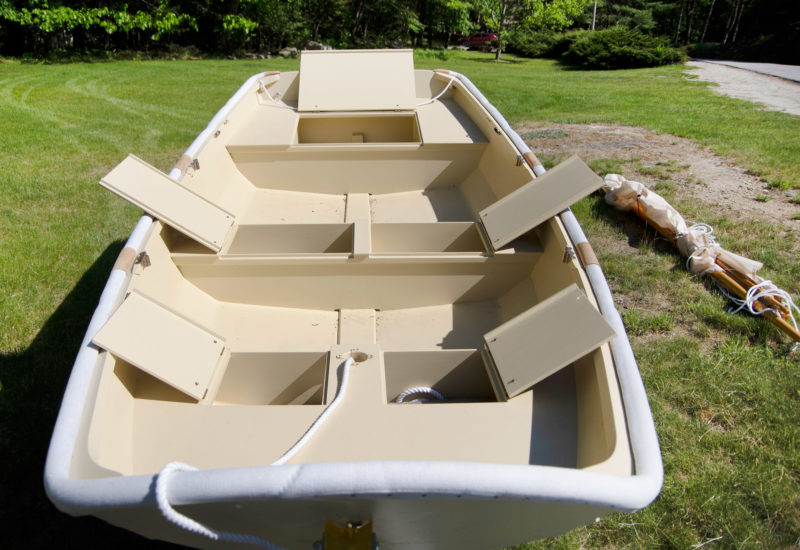 Bill Boyd
Bill BoydThe seating incorporates bulkheads and hatches to create ample storage space, eliminating clutter for the occupants.
Large seating areas in the bow and stern and two thwarts amidships have lots of enclosed storage space under them, accessed by hinged lids. These spaces are not airtight, so some might choose to include drybags or foam as flotation. The center thwart has a slot for the daggerboard, and the forward thwart accommodates the mast. My Oonagh has “firehose” gunwale guard around the coaming to protect nicely finished boats when coming alongside.
At 170 lbs or so, the Oonagh is not really cartoppable, but it can be easily slipped into a truck bed that is at least 60″ wide. I followed the designer’s recommendation and opted to trailer the boat. A light trailer that was intended for a jet ski proved an uncomplicated and easily maneuverable solution for me, and launching the boat with the trailer is an easy, singlehanded operation.
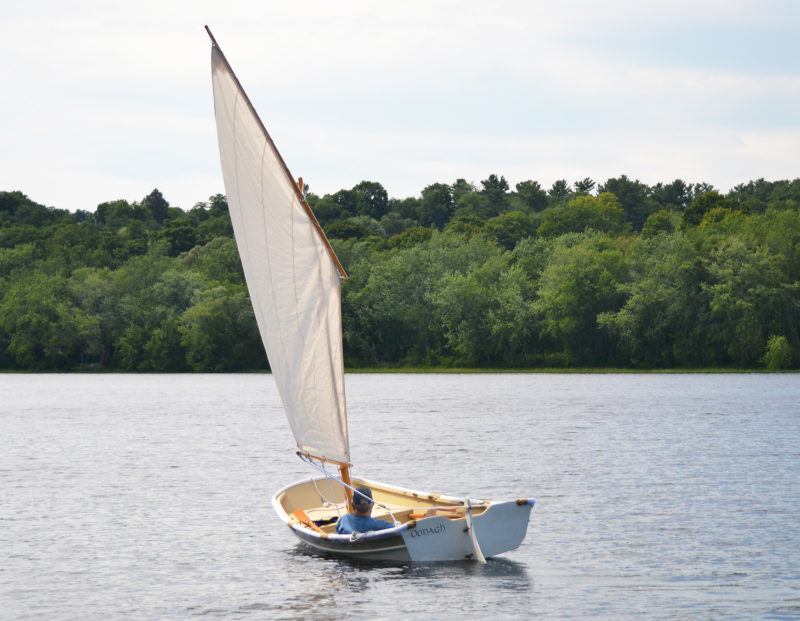 Bill Boyd
Bill BoydFor a sailor seated in the bottom of the boat, the angled sides provide a comfortable backrest.
Designs for prams vary widely, but typically the bow is carried well above the water and therefore provides little stability. If you go forward in such a pram, your weight tends to make the boat roll and tip easily, and standing in the bow can be precarious. Oonagh is different. Its bow is relatively wide and low and, therefore, buoyant. The hull’s breadth runs aft to a 5′ wide maximum beam before it tapers slightly to a relatively broad stern. When I climbed aboard for the first time, the bow looked stable, so I boldly stepped down from a height of at least 2′, over the bow transom, and onto the forward deck. I noticed that the boatyard crew nearby grew quiet as I prepared to drop down, but there was no need to worry; the bow dipped slightly under my 200 lbs, but the boat supported me well when I landed. Stability, I found, is an important characteristic of Hylan’s pram, and he notes that an adult can step with some confidence on the gunwale while boarding another boat or climbing onto a dock.
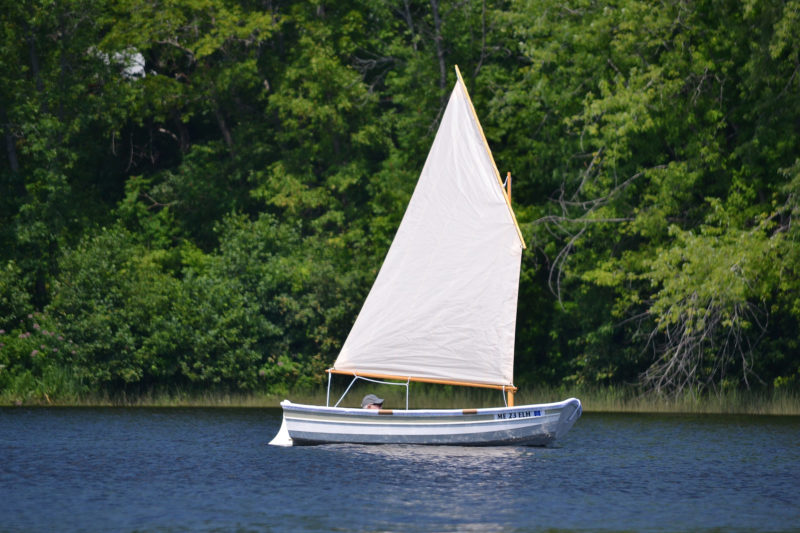 Bill Boyd
Bill BoydThe standing lug rig has a sail area of 68 sq ft.
The Oonagh is designed as a family boat, and there is enough space for a family if it’s just two kids and two adults, with the kids in the bow. I find it a little too cramped for four adults, although a sedate trip motoring up the river could be pleasant for four. Considering the boat’s stability, kids can be reasonably safe when they take the boat out to have fun on their own.
Under oars, the pram tracks very well and has considerable carry between strokes. It pushes through a moderate chop most satisfactorily and is just plain fun to row. I have found 7′ or 8′ oars are the best. There are two rowing stations; you can row from the forward station with a passenger seated in the stern, or solo from the aft station. “The same tucked-up transom that makes for decent rowing will preclude planing,” Doug notes, “so there is no point in putting anything more than 2 horsepower back there. In fact, 1 horsepower is as much as she can really use effectively. This begs the question—why not electric? Why not indeed! A small trolling motor will push her along nicely.” I have a 3-hp Torqeedo electric outboard for outings under power. The motor moves the boat fast enough—5 mph—at full power. I always carry oars as a back-up in case I exceed the battery’s range.
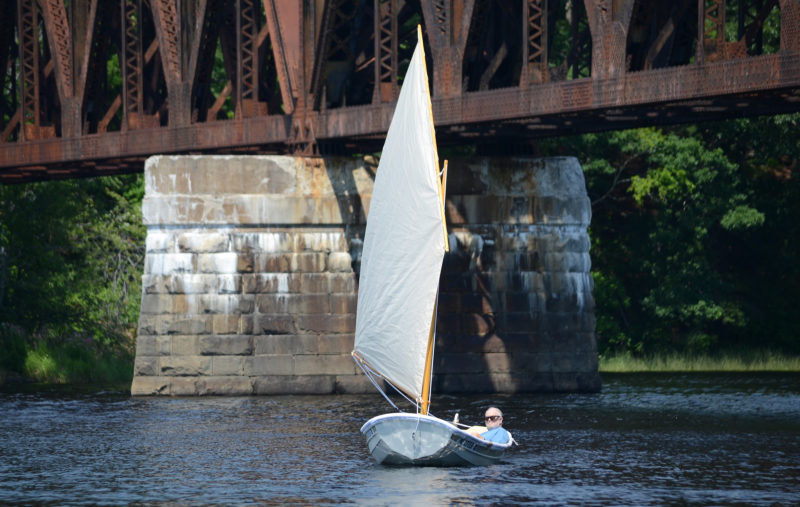 Bill Boyd
Bill BoydThe pram bow gives the Oonagh more volume, buoyancy, and stability forward than a boat with a sharp bow without adding to its length.
The Oonagh has a standing lug rig, with a boom and yard, which makes the 68-sq-ft sail particularly efficient and easy to control. The spars are all short enough to fit inside the boat for storage and trailering. Sailing the Oonagh is satisfying; it performs like a well-designed 12′ or 13′ sailing dinghy. It tracks quite well and points decently into the wind. Because of the high initial stability, it will heel only slightly, but in a stiff wind the sail will have to be shortened or carefully attended to. In an emergency while sailing, the yard can be dropped quickly along with the sail. The boom is attached to the mast with a single boom jaw and is easily controlled, but the yard can fly away from the mast when halyard tension is released, as it will be when lowering the sail. There are several good ways to prevent this from happening and, overall, the rig is simple and safe; excellent for kids or those learning to sail. When rounding up and coming alongside a float or dock the daggerboard, which draws 22″, makes the maneuver simple and quick, almost like turning on a dime.
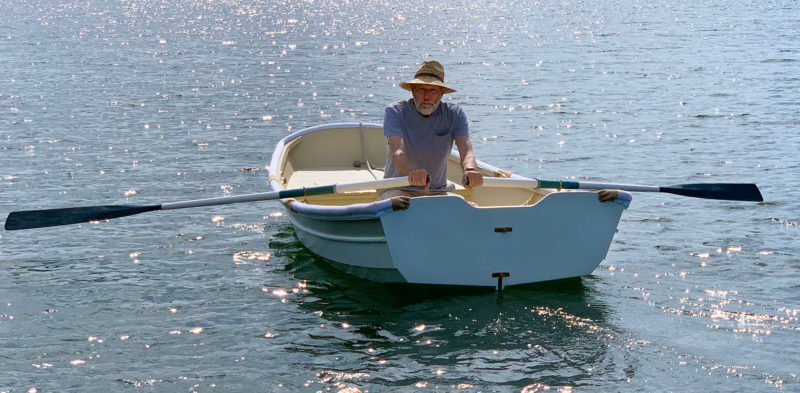 Benjamin Mendlowitz
Benjamin MendlowitzThe Oonagh carries its way well when rowed. The notch in the transom can accommodate a small outboard for those so inclined. The designer notes that a 1-hp gas outboard is plenty powerful enough for the displacement hull and that an electric motor would be a good choice.
I am a senior citizen, and in the Oonagh I have found a boat that can take care of me as much as I take care of it. Size is not an important factor for me; 11′-plus of length is plenty. Much more important is stability and the sense that, with care, I can stand or move about in the boat with confidence, and that once I find my spot while sailing or motoring, I can’t be easily thrown off balance or moved unexpectedly. It is a wonderful boat to come to terms with: if I sail the boat carefully, the boat will do me no harm. The Oonagh’s “nautical competence” enables me to feel totally comfortable while stretching out my legs while motoring slowly down the river or sailing in semi-protected waters. If I raise the board a bit, I can cruise among the grasses at the edge of the marsh, or I can reach for the oars to go to windward a bit before trimming the sail for the long reach home. I feel confident aboard the Oonagh. I noticed that right from the beginning, and the feeling is with me whenever I put it in the water.
The experience of owning an Oonagh for two years has not diminished my enthusiasm for the boat. I have owned a 19′ Caledonia Yawl, a 14′ catboat, and several double-paddle canoes and kayaks, and I consider myself to have a fairly good sense for performance, seaworthiness, and safety in a small boat. In those three categories I consider the Oonagh to be an excellent and remarkably capable boat. ![]()
Edgar “Bill” Boyd was attracted to boats the moment he moved near the Maine coast. He and his family summered for more than 50 years on an island in Eggemoggin Reach across from the WoodenBoat campus. He has built six boats including a Caledonia Yawl and a 22′ Ninigret, a John Atkin–designed bassboat. He and his wife now live in Yarmouth, Maine.
Oonagh Particulars
Length/11′ 8″
Waterline length/9′
Beam/60″
Draft/5″ board up, 22″ board down
Weight/Approximately 170 lbs
Sail area/68 sq ft
Power/electric or gas up to 2 hp
Plans and kits for the Oonagh are available from Off Center Harbor for $149 and $1,995 respectively.
Is there a boat you’d like to know more about? Have you built one that you think other Small Boats Magazine readers would enjoy? Please email us!
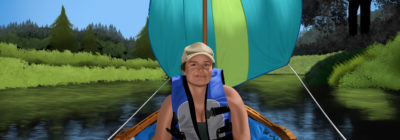
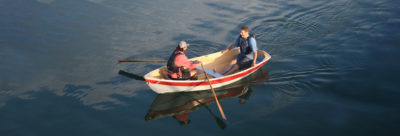






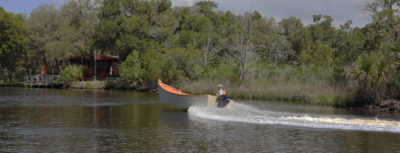
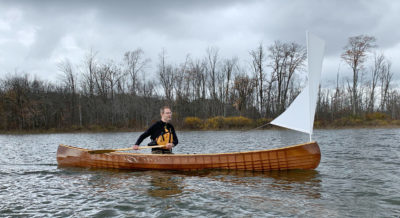
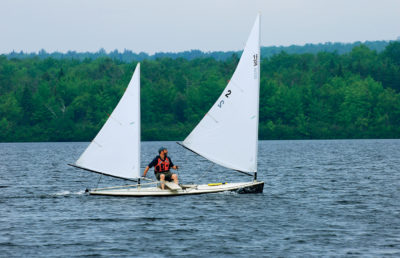
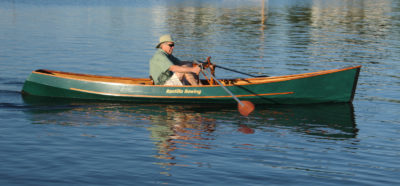
Although not a pram guy, I’m liking what I’m seeing with the lines fore and aft, balance and roominess.
The ballance seen here with the skipper comfortably between the thwarts is near perfect. The beam appears wider than it is. Not much of a flat bow guy, I like how the lapstrake comes together without too much bluntness.
If I needed a pram, this I would strongly consider!
Rob K
Wonderful article. I love my Shellback—the small size and rowing ability—but I often find myself wishing for a tad bit more space. Some additional stability would serve as well. And the option for an electric outboard would expand our use.